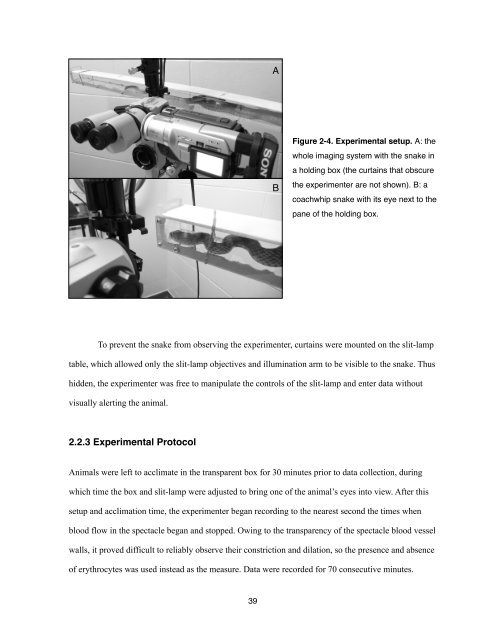Chapter 1, The Reptilian Spectacle - UWSpace - University of ...
Chapter 1, The Reptilian Spectacle - UWSpace - University of ...
Chapter 1, The Reptilian Spectacle - UWSpace - University of ...
You also want an ePaper? Increase the reach of your titles
YUMPU automatically turns print PDFs into web optimized ePapers that Google loves.
Figure 2-4. Experimental setup. A: the<br />
whole imaging system with the snake in<br />
a holding box (the curtains that obscure<br />
the experimenter are not shown). B: a<br />
coachwhip snake with its eye next to the<br />
pane <strong>of</strong> the holding box.<br />
To prevent the snake from observing the experimenter, curtains were mounted on the slit-lamp<br />
table, which allowed only the slit-lamp objectives and illumination arm to be visible to the snake. Thus<br />
hidden, the experimenter was free to manipulate the controls <strong>of</strong> the slit-lamp and enter data without<br />
visually alerting the animal.<br />
2.2.3 Experimental Protocol<br />
Animals were left to acclimate in the transparent box for 30 minutes prior to data collection, during<br />
which time the box and slit-lamp were adjusted to bring one <strong>of</strong> the animal’s eyes into view. After this<br />
setup and acclimation time, the experimenter began recording to the nearest second the times when<br />
blood flow in the spectacle began and stopped. Owing to the transparency <strong>of</strong> the spectacle blood vessel<br />
walls, it proved difficult to reliably observe their constriction and dilation, so the presence and absence<br />
<strong>of</strong> erythrocytes was used instead as the measure. Data were recorded for 70 consecutive minutes.<br />
39<br />
A<br />
B
















